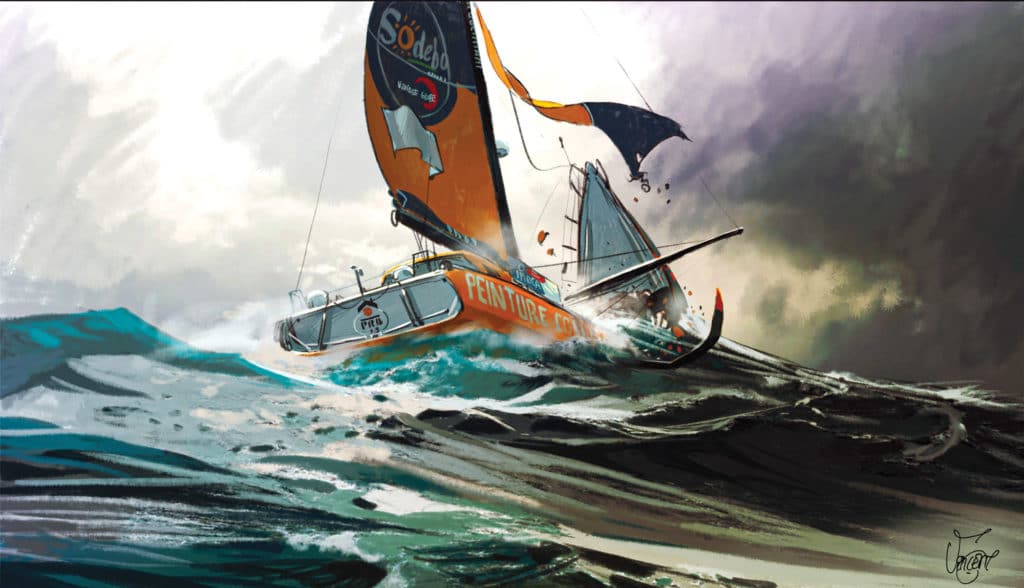
All was fine aboard PRB, skipper Kevin Escoffier’s IMOCA 60, on November 30, 2020, at 1340 hours UTC. The 40-year-old French singlehanded skipper was racing in 25-knot southwesterly winds and 16-plus foot seas, some 840 nautical miles southwest of Cape Town, South Africa, in the 2020-21 Vendée Globe race.
Roughly 10 minutes later, PRB was ripping along at 27 knots when the boat buried its bow into a wave—a common occurrence for IMOCA 60-class boats, which are designed for the blustery Southern Ocean, where Escoffier was headed. Only this time, the boat broke in half just forward of the mast bulkhead, and PRB’s bow section thrust vertically toward the sky.
Three minutes later, Escoffier was in his survival suit in the water, trying to climb into his life raft. His around-the-world sailing race turned into a race against time as the ocean proved that even a stout vessel with top-notch technology and a seasoned skipper sometimes are not an equal match.
The Vendée Globe was founded in 1989 as the Globe Challenge. Philippe Jeantot, a French skipper who had won the 1982-83 and 1986-87 editions of the BOC Challenge, wanted an even tougher endeavor. He devised the Globe Challenge as a singlehanded, nonstop, around-the-world race that would be contested using 50- and 60-foot open-class monohulls.
Frenchman Titouan Lamazou won the inaugural edition, which saw 13 boats compete. Of these, seven boats finished while one capsized, one was dismasted, three suffered damage, and one skipper quit due to a medical emergency.
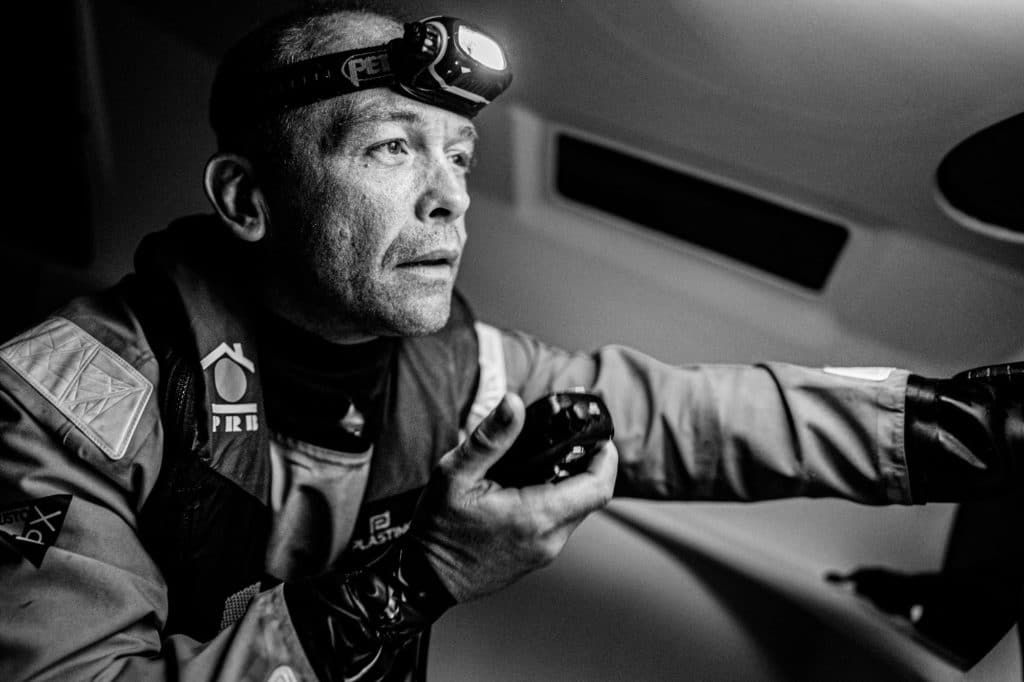
The first edition of this now-legendary race set some important precedents. Lamazou was the first of nine Frenchmen to win the race in as many editions, and the high attrition rate experienced in the inaugural Globe Challenge has repeated itself in each edition of the Vendée Globe. Capsizes, dismastings, rudder damage, structural damage, collisions and medical calamities have become common race-ending plights. Tragedy has also visited the race: British skipper Nigel Burgess, sailing aboard Burgess Yachts, and Canadian skipper Gerry Roufs, sailing aboard Groupe LG2, were lost at sea during the 1992-93 and 1996-97 editions, respectively. American Mike Plant, sailing aboard Coyote, was lost at sea en route to the 1992-93 race.
Given France’s dominance atop the race’s podium, the Vendée Globe has become wildly popular there. The race’s lore gained additional gravity in the 2016-17 edition, which saw the newest IMOCA 60 designs adopt hydrofoils that partially lifted the boats from the water and increased their speed potential. Case in point: Lamazou won the inaugural race in 109 days, eight hours, 48 minutes and 50 seconds; Armel Le Cléac’h, sailing aboard the foil-equipped IMOCA 60 Banque Populaire VIII, won the 2016-17 edition in 74 days, three hours, 35 minutes and 46 seconds.
These dramatically faster times require more-radical designs and an increased reliance on hydrofoils that, while fast, put different loads on a hull than the displacement boats of yore.
While Escoffier’s PRB was fairly contemporary, it was penned and built as a displacement boat by Verdier and VPLP for the 2012-13 Vendée Globe; it was retrofitted in 2017 with hydrofoils in preparation for the 2020-21 race.
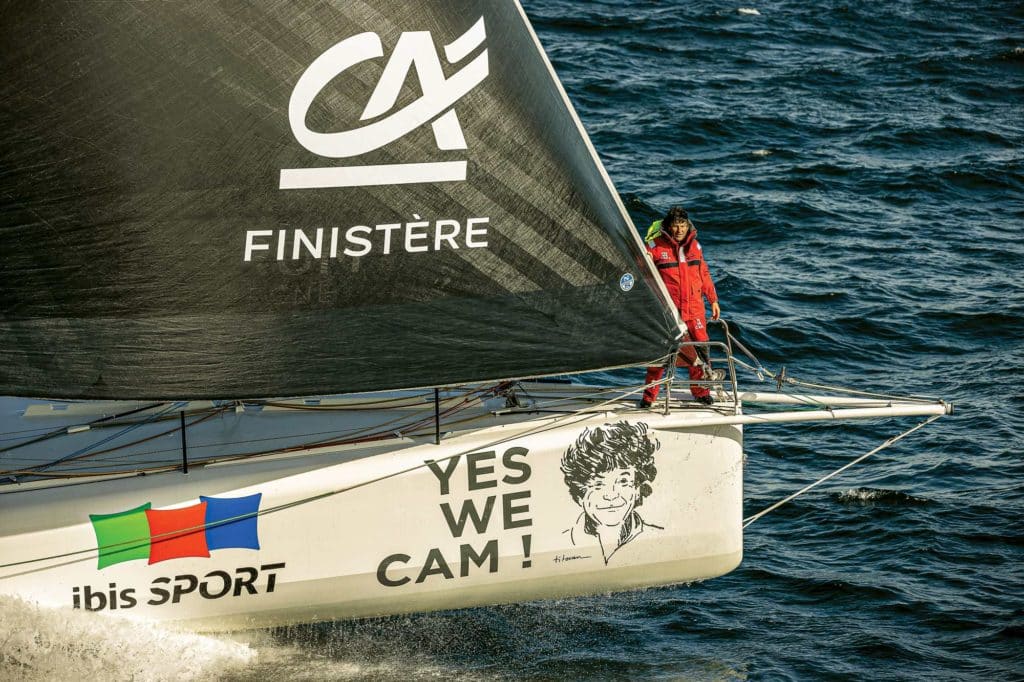
When the emergency occurred, PRB made a loud bang, and Escoffier had seconds to react. He immediately activated his EPIRB, donned his survival suit, and sent a message to his shore team in France. It simply read: “I’m sinking, I’m not joking. MAYDAY.” Smoke began pluming as PRB’s electronics shorted. Less than two minutes later, Escoffier was struggling to get into his life raft.
Escoffier’s EPIRB reported its position at 1353 hours UTC to the International COSPAS-SARSAT Programme, which monitors for emergency signals. In turn, COSPAS-SARSAT Toulouse notified the Maritime Rescue Coordination Center Griz-Nez, which notified race officials and the MRCC Cape Town. Race officials began contacting other nearby skippers to suspend racing and help. Jean Le Cam, a Frenchman sailing aboard YesWeCam in his fifth Vendée Globe, was the closest competitor and immediately headed toward PRB’s last-known location. Race officials also directed Boris Herrmann of Germany, sailing aboard SeaExplorer-Yacht Club de Monaco, Frenchman Yannick Bestaven aboard Maître CoQ IV, and Frenchman Sébastien Simon aboard Arkea Paprec to help search for Escoffier.
Le Cam arrived on scene at 1615 hours UTC and established voice and visual contact with Escoffier, who had also activated his man-overboard beacon with AIS. Unlike EPIRBs and personal locator beacons, which transmit 406-megahertz emergency signals to satellites, AIS MOBs rely on VHF radio waves (read: line of sight) and can only be detected locally using an AIS receiver. The problem, however, was the rough conditions: The 16-foot seas meant that some signals were lost when Escoffier’s life raft was in the wave troughs, and the 25-knot winds and dying light made it impossible for Le Cam to get close enough to the raft to make the transfer safely.
Le Cam ultimately lost sight of Escoffier while he was maneuvering YesWeCam. Darkness fell. Escoffier deactivated his AIS MOB.
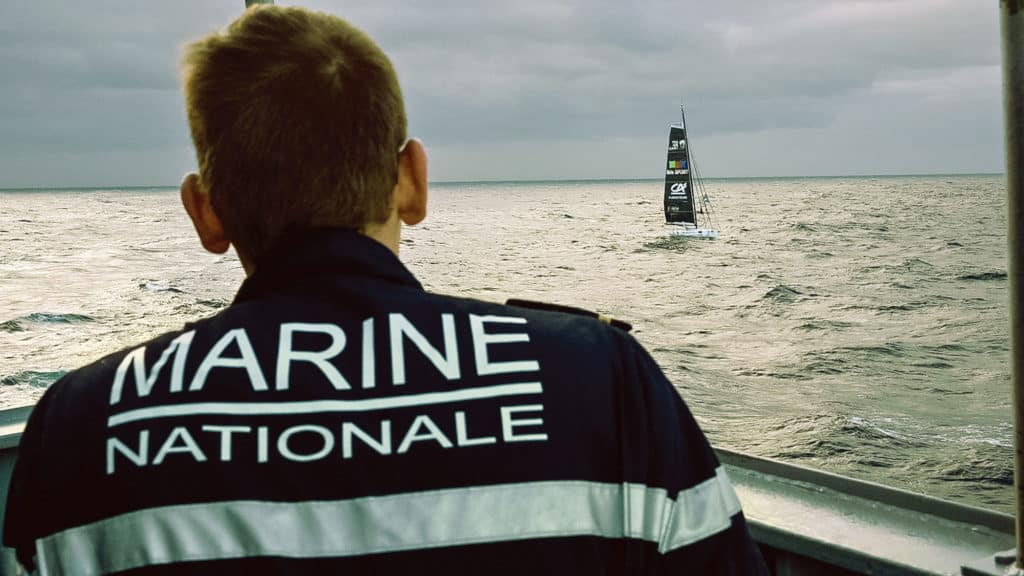
The Vendée Globe’s race director instructed all four responding skippers to execute search patterns. Race officials also worked with Meteo France’s drift-prediction model to give the skippers better search information based on Escoffier’s last-known EPIRB position.
The breakthrough came when Le Cam was directed toward a beacon position that aligned with the drift-prediction model. He soon spotted a light reflecting off a wave.
It was Escoffier.
The search was over, but now came the challenge of transferring Escoffier from his life raft in big seas. Fortunately, the moon provided enough light to see. The two skippers exchanged a few words, and Le Cam worked to bring his boat alongside the life raft. When YesWeCam was roughly 15 feet away, he threw a line with a buoy to Escoffier. The two men pulled on their respective ends until the raft was close enough to YesWeCam’s stern for Escoffier to climb aboard.
All told, he spent 11 and a half hours in his life raft.
“I’m doing pretty well, pretty well—much better than last night, which I spent in a very bad bed-and-breakfast,” Escoffier joked to the Vendée Globe English Live program from aboard YesWeCam. “It’s unbelievable what happened. The boat folded up on a wave at 27 knots. I heard a bang, but to be honest, I didn’t need to hear that to know what had happened. I looked at the bow. It was at 90 degrees. In a few seconds, there was water everywhere. The stern was underwater, and the bow was pointing up to the sky. The boat split in half in front of the mast bulkhead. It was as if she folded up. I promise, I’m not exaggerating. There was an angle of 90 degrees between the stern and the bow.
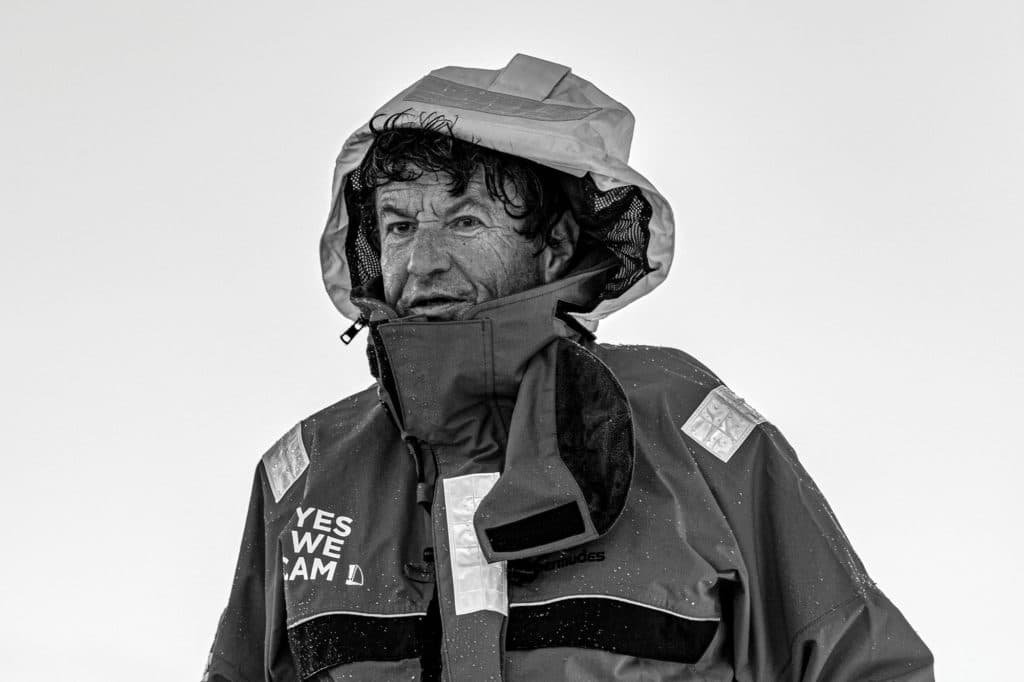
“I didn’t have time to do anything,” he continued. “I just had time to send a message to my team. Between the moment when I was out on deck trimming the sails and when I found myself in my survival suit, barely two minutes had passed. It all happened extremely quickly.”
Escoffier was transferred from YesWeCam to the 307-foot French navy frigate Nivôse at 0210 hours UTC on December 6, via the frigate’s RIB. From there, the Nivôse sailed to Reunion Island, where Escoffier began his journey back to France.
While it was still unclear at the time of this writing what caused PRB to fail catastrophically (or possibly to have sunk), there’s no question that Escoffier’s technology, training and quick thinking helped ensure his survival. There’s also no question that the selfless actions of Le Cam, Herrmann, Bestaven and Simon—along with the Vendée Globe’s coordination efforts—also played significant roles.
Now, Escoffier is turning his attention to the 2024-25 Vendée Globe. But first, he will work with naval architects to try to determine why PRB failed and—more important—how they can design and build an IMOCA 60 that’s strong enough to gird the planet yet light enough to win this storied offshore contest.









